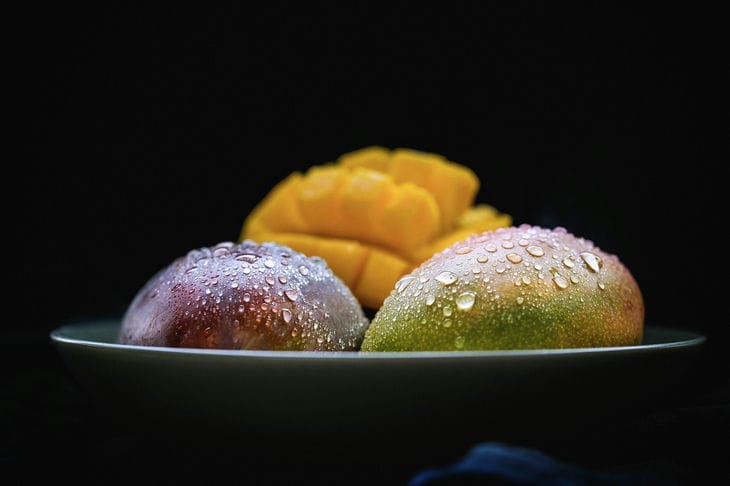Is it worth eating mango peel: benefits or harm
The hard skin of the fruit protects its flesh from the effects of the external environment.
Most often, the peel is thrown away, although in most cases the shells are edible and contain a large amount of nutrients and various plant compounds.
With widespread awareness of the dangers of pesticides applied to fruits and vegetables, most people are afraid to eat the peel, even though the peel of some fruits, such as mango, guava, grapes, plums and apples, contains more vitamins, minerals and nutrients than their flesh.
The incredible nutritional value of mango peel is legendary, but many people consider it poisonous. Should you eat mango peel?
Benefits of Eating Mango Peel
- Reduces blood sugar levels.
- Helps fight some forms of cancer.
- Reduces blood cholesterol levels.
- Reduces oxidative stress.

Mango is sometimes called the king of fruits, mango fruit is one of the most popular and nutrient-rich fruits, it is very tasty and has a fragrant aroma.
You can learn a lot about eating fruit by watching monkeys. They will eat the skins of certain fruits and throw away the skins of others.
For example, a monkey will peel a banana (implying that banana peels are not actually edible for humans), while it will eat a mango peel (implying that mango peels are edible).
Research presented at the Australian Congress of Medical Research in Melbourne has found that some plant compounds found in mango peels help fight diabetes and some forms of cancer.
These substances affect PPAR receptors, which help control blood cholesterol levels on the one hand and glucose levels on the other.
Thus, consumption of mango peel will be beneficial for people suffering from diabetes and cardiovascular diseases.
Since PPAR receptor activity has also been linked to some types of cancer, substances in mango peel may have anti-cancer effects.
Scientists do not yet have a complete list of the compounds found in mango peel, but some of them have already been well studied.
One of them is quercetin, a molecule with antioxidant activity. Quercetin is also found in plants that are predominantly red or purple in color, in many vegetables such as tomatoes, peppers, garlic, in citrus fruits, and in many berries.
Another compound found in mango peel is mangiferin, which sequesters excess free iron in the body to protect it from oxidative damage.
The third substance, noratheriol, is also an antioxidant.
Mango peel also contains resveratrol, which lowers blood cholesterol. Resveratrol is also found in the skin of blue grapes. Wines and juices from all dark berries are good sources of resveratrol.
Mango pulp contains a large amount of sugar or glucose. Eating mango without the skin can cause a sharp increase in blood sugar levels.
This is why fruits that contain a lot of sugar often have peels that contain substances that regulate digestion and metabolism in the body.
Disadvantages of Eating Mango Peel
- May cause an allergic reaction.
- Doesn't taste good.
- May contain pesticides.
Mango peel can cause severe allergic reactions due to urushiol, a toxin that is also found in poison ivy. This is why mango peel is often mistakenly considered poisonous.
Symptoms of a reaction to mango peel do not appear immediately. It may take 10 to 21 days for the first symptoms to appear. After this time, it will be difficult for doctors to understand what caused the rash.
The rash is characterized by redness and swelling, sometimes with papules, blisters, or vesicles. The rash may appear on and around the mouth and extend to the throat and eyes.
Most often, the rash goes away on its own within a week or two. In more severe cases, the rash can persist for up to five weeks. Scratching the rash can lead to an infection that will need to be treated with antibiotics.
A major drawback to eating mango peel is its bitter taste. The tart peel can interfere with the unforgettable sweet taste of the pulp.
To protect against diseases and insects, mango plantations are treated with pesticides.
Research shows that pesticides have a negative impact on human health only in very large doses. They are present in small quantities in fruits and vegetables.
To eat or not to eat
People who value the nutritional value of a product over its taste and who are not allergic to urusilol should eat the mango peel.
In India, most locals prefer to eat mangoes whole, with the skin. Sometimes the mango skin is peeled and dried in the sun, and then eaten as a snack.
People with allergies should avoid eating mango peel. The same valuable nutrients found in mango peel are found in other fruits and vegetables, so it's enough to include a variety of fruits and vegetables in your diet to ensure you're getting enough nutrients.
Earlier we talked about why matches are added to the pan when boiling eggs.
